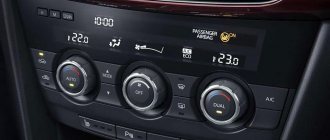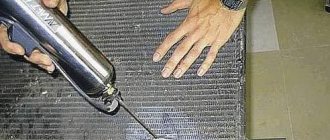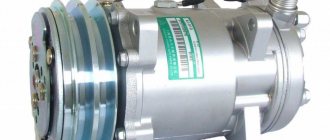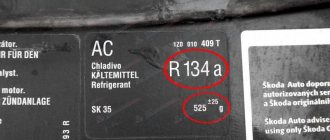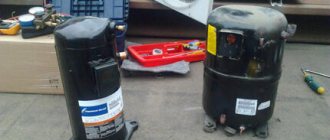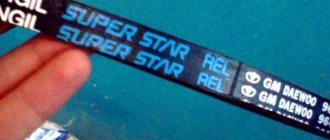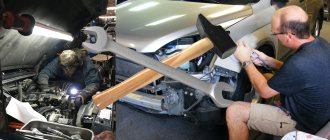Air conditioning has become an almost indispensable component of any modern car. With its help, you can create and maintain an optimal microclimate in the cabin. But, like any other equipment in a car, the air conditioner needs preventive maintenance and periodic maintenance. Many who own a car with such a system have repeatedly contacted service centers with the problem of air conditioner failure. This is mainly due to leaks and consumption of freon, the reserves of which must be replenished. Using professional equipment for refilling car air conditioners, service centers ask decent amounts of money for their services. The minimum cost of refilling is 1000 rubles. But the car owner can save a lot by dealing with this element of the car with his own hands.
Recommendations for choosing and using freon for car air conditioning.
Refilling the car air conditioner
With the beginning of the summer season, customers are increasingly asking: “refill the air conditioner.” To the question “Why?” they usually answer: “The freon has run out, the car is already five years old,” “The air conditioner has started to blow poorly,” “I fill it up every year,” etc.
Indeed, refilling is required when the freon has “left” the system. But, as mentioned earlier, the air conditioning system is closed and sealed, so freon is not a consumable item. It just cools the evaporator by moving inside. This means that refilling in this case does not eliminate the problem itself - the leak. One-time measures work temporarily.
When to refill your car air conditioner
Every year, for natural reasons, the amount of freon in the cooling system decreases by 10-20%, so it is necessary to periodically refill the air conditioner. Please note that the power of the device drops significantly even if the freon loss is 50 percent or more.
It is recommended to refill your car's air conditioner at least every 3 years!
Do-it-yourself refueling of a car air conditioner is required in the following cases:
- Violation of the tightness of pipes;
- Mechanical damage to pipes;
- Condenser coated with rust.
Car air conditioner freon leak
There are different types of air conditioner leaks. For example, on some large SUV that arrived in the spring with the firm confidence of refueling, when connecting a gas station to it, from under the wheel in the rear circuit of the air conditioner, a rotten tube or hose with a telltale hiss throws clouds of freon into the air, simultaneously dousing everything around with compressor oil. Of course, refueling with such a “hole” is simply not possible.
It often happens that the high pressure hose bursts. The system loses its tightness and, again, it is impossible to refill it. Leaks can be of different sizes, sometimes freon can last for 3 months or even six months.
How can you tell if your air conditioner is running out of freon?
- The air conditioner does not cool the air well
- doesn't cool at all
- Oil appeared on the refrigerant pipes
- or frost in the indoor unit.
“If the air conditioner stops cooling, then this most likely indicates that there is a leak in the system. As a rule, this is immediately visible. If you charged the air conditioner, the car sat for literally ten minutes, and after turning on the air conditioner still did not blow cold air, then in this case there may be a freon leak, so the entire system is checked for leaks. If the air conditioner blows cold air, but not strongly enough, then the cabin filter is clogged,” says Stebakov.
If leaks occur regularly and in significant quantities, then there is no point in refilling the air conditioner. In this case, all problems must be resolved at the service center.
Preparing for refueling
First of all, before refueling the air conditioner in the car with your own hands, you need to find and eliminate leaks, as well as perform vacuuming.
If the leaks are small, you can fix them yourself; for larger damages, we recommend contacting a car service center.
Finding and fixing leaks
If the freon in the air conditioner runs out due to damage to the pipes, then in this case you need to find and fix the leak. To find leaks, it is recommended to use a special tool called a leak detector . If there is no such device, then find the leak location as follows:
- Make a liquid mixture based on oil and freon;
- Add a special ultraviolet dye to the mixture;
- Refuel and turn on the air conditioner;
- After 5-10 minutes, take an ultraviolet lamp and shine it on the air conditioner - the damaged areas should turn greenish-yellow.
To eliminate a leak:
- Take a metal pipe and cover the leak with it;
- Place 1 clamp on both sides of the pipe;
- Degrease the place where the clamps are attached (for example, with alcohol);
- Secure the coupling parts with electrical tape.
- Apply glue to the coupling, place the coupling on the pipe and tighten the clamps.
Pressure test
After eliminating leaks, it is necessary to check the integrity of the system. To do this, you should fill the air conditioner yourself with some safe gas (for example, nitrogen).
After refueling, be sure to measure the pressure - if after 30 minutes the pressure has not changed, this means that the system is completely sealed. Otherwise, repair any remaining leaks and repeat the test procedure.
Evacuation of the air conditioner
Now you need to evacuate the device to remove air and moisture droplets from the system. For evacuation you will need a special vacuum pump, and the procedure itself is as follows :
- Turn on the heating system and warm up the car (if this is not done, then a lot of moisture will remain in the evaporator);
- Take the vacuum pump and connect it to the car air conditioner - to do this, attach the pump pipe to the pipe;
- Turn on the pump for 10-15 minutes. After this, close the valve and turn off the pump. Repeat the procedure 2-3 times;
- Finally, turn off the pump and wait 2-3 hours for the temperature and pressure to normalize. After this, you can proceed directly to refueling.
Procedure for refilling a car air conditioner
An automatic device is used to recharge car air conditioners. With the help of such equipment, the possibility of human error during the procedure can be eliminated as much as possible. And the presence of a built-in car catalog allows you to refill the air conditioner of almost any vehicle.
The operating principle of this equipment can be represented as follows:
- It is connected using hoses to special connectors of the car cooling system.
- The vacuum motor pumps freon into a special container inside the housing, simultaneously cleaning it using filters.
- Then the motor evacuates the car's air conditioning system.
- After which, if there are no leaks, it is filled with purified refrigerant.
- In this case, if necessary, new freon is pumped up to the required quantity. If required, compressor oil is added.
The entire cycle of work can be carried out either fully automatically or manually.
Necessary materials and equipment
Now all car air conditioners are filled with tetrafluoroethane (labeled R-134a), but in the old fashioned way, car enthusiasts still call this refrigerant freon, since the cooling systems of cars produced before the early to mid-90s were filled with CFC-12 freon.
Mixing different types is not allowed; the exact name of the refrigerant can be found on the sticker on the inside of the hood.
A bottle of freon weighing half a kilogram will cost about 1,000 rubles, larger containers will cost several thousand rubles.
For air conditioners in small passenger cars, a bottle of 500 grams is enough, but for larger and more powerful cars you can get by with two bottles
To refuel your car you will need one of the following devices:
- automatic station (costs tens of thousands of rubles);
- single or reusable set of equipment.
Naturally, buying an automatic station when refueling yourself is out of the question - it will cost too much. But it’s worth taking a closer look at the sets. A complete one consists of:
- manifold;
- scales;
- a cylinder filled with freon;
- vacuum pump.
The disposable kit is very inexpensive and includes a bottle, hose and pressure gauge. Also in both cases you will need adapters and fittings.
A disposable kit is cheaper, but less reliable, a reusable kit is the opposite.
The choice between these two options is the car owner's decision.
Price for refilling the air conditioner and related services
- Basic check of a car air conditioner for leaks – 500 rubles
- Refilling the air conditioner: 1000 – 3000 rubles
- Air conditioner diagnostics: 899 – 1500 rubles
- Flushing the radiator cooler and eliminating unpleasant odors: 1299 – 2000 rubles
- Replacement of air conditioner dryer – from 1500
- Replacement of air conditioner tube – from 900
- Removal/installation of air conditioning compressor – from 2250
- Replacement of air conditioner evaporator – from 4500
- Replacement of radiator (condenser) – from 2250
- Compressor repair – from 1700
For the service of refilling a car air conditioner, the price is formed taking into account several parameters, the list of which includes the volume of refrigerant circulating in the system, as well as the need for additional maintenance (flushing the radiator cooler and eliminating unpleasant odors). The scope of work includes diagnosing the air conditioner at an automatic station for major leaks by vacuuming the system, pumping out old freon and oil, and then refilling with new freon and oil.
Freon selection
If you decide to replace consumables in the system yourself, then first of all you need to familiarize yourself with the volume table. Also important is the choice of refrigerant itself. In cars manufactured before 1992, R-12 type refrigerant was used to charge car air conditioners. Today, this type of freon is not relevant; since 1992, manufacturers have been using R-134a type liquid. In accordance with this information, based on the year of manufacture of the vehicle, the motorist can easily select the required freon.
Pay attention to one thing. Around cars produced in 1992-1993, a controversial situation has arisen regarding the determination of the type of consumables that need to be used. This was a transitional moment, so not all vehicle manufacturers had time to switch to the new refrigerant.
Freon volume table for different cars
To determine exactly what type of gas you need to use in your case, we recommend taking into account several points. On the back of the hood in many modern cars there are special plates that display all the necessary information about the brand of air conditioner, as well as the refrigerant that must be used in this car. It should also be noted that the filling fittings may differ from each other. As practice shows, for the newer type of freon - R-134a, the fittings are taller, and their diameters are also usually larger.
Care at different times of the year
A car air conditioner, like any other device, requires specialized care. In the summer, when the air conditioner is often used, it is enough to monitor the refrigerant level and the condition of the freon lines. But in winter, preventive measures are required.
In the cold season, when the car air conditioner is not planned to be turned on, the air conditioning system needs special care.
Expert advice:
- Clean the radiator from dirt, dust and fungal growths in a timely manner.
- Constantly monitor the oil level.
- Monitor the condition of the connecting tubes and rubber gaskets, as sudden changes in temperature conditions negatively affect their walls.
Most often, the compressor in the system fails, namely the capacitor, since it is installed directly next to the engine radiator. The condenser is constantly exposed to dirt and dust coming from the road, which leads to clogging and microcracks, which in turn contributes to refrigerant leakage. Therefore, it is necessary to monitor the cleanliness of the engine compartment in order to extend the life of the car air conditioner.
To do this, follow simple rules:
- Monitor the pressure in the cooling system.
- Check filters in a timely manner and change them if necessary.
- In winter, turn on the car air conditioner at least once a month to avoid stagnation. In this case, switching on should occur either in a heated box or when the outside temperature is above 0°C.
- Clean the evaporator once every six months.
What freon is used in car air conditioners
Every owner of a car equipped with a climate system must know what kind of freon is poured into his car air conditioner. This is very important, because using the wrong refrigerant will damage the cooling system.
Initially, since the forties of the last century, car air conditioners were filled with chlorine-containing freon R12. In 1990, new legislation decided that the use of chemicals that rapidly deplete the ozone layer should be banned. This rule also applies to freon R12. As a result, by 1993, a new refrigerant, R134a, was put into operation, which is still used today in most air conditioning systems.
So that car owners and car service technicians can easily distinguish between the types of freons used, manufacturers of car air conditioners decided to install other filling fittings for 134 freon.
So:
- the fittings designed for R12 are very similar in appearance and size to wheel nipples with a black dust cap screwed on top, and the quick-release internal coupling required for refueling the system is screwed onto the top thread;
- fittings for R134a have an increased diameter and length, reminiscent of quick-release connections for pneumatic tools, while the filling valve is held on the fitting by tightly fixing it with stops by the groove, and the plastic protective caps of the fittings are colored.
Is it possible to refill a car air conditioner with another freon?
The type of freon in car air conditioners is indicated on a special sticker under the hood of the car, as well as on one of the car air conditioner units.
R12 filling gas is currently practically not produced and is significantly more expensive than modern R134a, so filling/refilling the climate system with such freon is difficult. At the same time, upgrading cooling equipment is also not easy and financially unprofitable, because the process requires replacing many elements, first of all, an expensive compressor.
Be that as it may, it is necessary to refill the car air conditioner only with the type of refrigerant recommended by the manufacturer. Otherwise, the reaction products of incompatible freons and oils will jam the air conditioning system of your car.
Which freon is better for car air conditioning
Like any product, refrigerant can be counterfeited and sold illegally. Usually, unscrupulous sellers lure consumers with low refill prices. Such “savings” will clearly not be beneficial, because impurities of chlorides and other harmful elements can cause corrosion of units and components of the cooling system, as well as harm the health of the driver and passengers, spreading harmful fumes throughout the car interior.
Note: Since 2011, according to the new European standard, R134a has been replaced by the highly environmentally friendly refrigerant R1234yf. If you are the owner of a car with a new type of freon, but do not know where you can refill the climate system with it, feel free to come to our car service center!
sto.ms
Refilling your car air conditioner yourself – is it worth it?
Many car owners, in an effort to save money, choose to refill their car's air conditioner themselves. However, specialists from the Kolesa Darom service center do not advise repairing car air conditioners on their own, as well as refilling them.
Not every car enthusiast knows that there are certain standards for refilling car air conditioners for different brands of cars. For example, the minimum operating level of freon for a Lada Priora should not be less than 330 g, and in the case of a Hyundai Solaris car, this figure should not fall below 425 g. In addition, service centers use special equipment, without which it is impossible to achieve the desired result . And in any case, an experienced master will do the job much faster and more accurately.
Video
Step-by-step instructions for refueling
Regardless of the make and model of the car, the general part of the correct instructions for refilling the car air conditioner with a disposable kit is as follows.
- It is necessary to remove the protective cap from the low pressure line port. If there is debris in the inlet, thoroughly clean it and the cap. Not a single piece of dirt or debris should enter the system, otherwise the compressor may fail.
- We put the car in neutral gear and handbrake. After this, start the engine and keep the speed at 1500 rpm. At this moment, an assistant is needed to hold them at a given value using the gas pedal. An alternative is to place something under the accelerator.
- We turn on the air recirculation in the cabin to maximum.
- You need to put the hose on the filling fitting and connect it to the hole in the low pressure line.
- We turn the low pressure line tap, having first turned the bottle of refrigerant upside down. Next, slowly turn the valve.
- While refilling the air conditioner, we maintain the pressure using a pressure gauge. It should not exceed 285 Kilopascals (kPa), it is best to keep it at around 275 Kilopascals.
- As soon as the temperature of the air leaving the deflector reaches 6–8 °C, and the fitting next to the low pressure port is covered with ice, refueling can be considered complete.
Video: refilling the car air conditioner with your own hands
However, the simplified scheme does not always give the desired result. Therefore, motorists have the right to use a complex method and an expanded range of equipment. In this case, the refueling scheme is slightly modified. First, the system is diagnosed using a tester, but the lack of freon can be determined “by touch.”
If the low pressure pipe remains warm when the air conditioning is turned on, there is not enough freon in the system
Once you are sure that refueling is necessary, proceed as follows.
- First, all refrigerant is removed from the air conditioning system.
- Air and liquid are then pumped out using a vacuum pump. Vacuuming is carried out within half an hour.
- Next, using a scale or measuring flask, the amount of refilled freon is measured.
Further refueling looks the same as in the first case, only the pressure of the incoming gas is controlled using a pressure manifold, rather than a conventional pressure gauge.
Which option is better?
Before the advent of automatic stations, manual refueling was the only possible method. If the technician is properly qualified, the result of such refueling will be similar to servicing using an automatic station. But to optimize production and eliminate the risk of a workshop technician’s error, it is more profitable to use automatic stations.
There are some advantages from such a solution for car owners, since professional stations are not only able to make the system cleaner, but also show the actual pressure in the system before refueling, and the amount of freon pumped out. Pressure gauges are installed at each station to show the actual pressure in the high and low circuits. This allows you to assess the cleanliness of the condenser immediately after refueling, correlate the pressure in the high circuit from the moment the fans turn on, and evaluate the performance of the compressor. Due to lower labor costs for owners, refueling using a station costs less and takes less time.
Symptoms of Low Refrigerant
- The air conditioner is not very cold.
- When you turn on the air conditioner, a characteristic hissing sound is heard from under the dashboard.
- Unpleasant odor when the air conditioner is running and after it is turned off. The cause of the smell is incomplete cooling of the evaporator. Warmer areas where bacteria and fungus have formed give off a musty, unpleasant odor.
- The air conditioner does not turn on. The control unit registers low freon pressure and therefore blocks the start of the compressor to maintain system functionality.
Useful tips
In order for the car air conditioner to be refilled successfully and for it to work for a long time, it is recommended to listen to the advice of specialists.
Tips for refueling and operating car air conditioners:
- When refilling, it is advisable to use freon with oil. The additive is written on the refrigerant bottle. Then you won’t have to add oil to the air conditioner, especially since few car owners know how to do this. In addition, there is a high risk of overdose, which can cause damage to the piston pump. The oil is dosed in the bottle.
- If the unit does not cool well, and frost is visible on the valves or heat exchanger of the indoor unit, refueling is necessary.
- To make your air conditioner last longer, flush its radiator from time to time.
- In winter, when entering the garage, turn on the air conditioning for about 10 minutes. Do this monthly during the cold season.
Refilling with freon requires the car owner to have certain knowledge, skills, and most importantly, special equipment and consumables. If you don’t need to look for a leak or repair the system, there is nothing complicated in this process, the main thing is to follow the instructions and perform all the steps sequentially. If you are unsure of your abilities, entrust the maintenance of the cooling unit to car service workers.
Preventative measures are always cheaper than repairing faults
Like any component of a car, the air conditioner needs maintenance. For the system to function properly, it is not enough to refill the freon. Periodically you need to wash the radiators, condenser, change the filter drier and disinfect the evaporator.
To prevent the formation of foul-smelling bacteria on the evaporator, turn the temperature control to warm air after operating the air conditioner. 1-2 minutes in this mode will dry the condensate from the evaporator, removing a favorable environment for the growth of bacteria.
Replace the thermostatic valve, throttling valve mesh, compressor shaft seal, pulley bearing, and rubber seals throughout the system as they fail and the first signs of a malfunction/refrigerant leak appear.
Why do you need to change the filter drier?
The filter drier is designed to retain compressor wear products - particles of Teflon seals, metal shavings. Filtration is necessary to prevent clogging of the throttle valve and the entry of abrasive dust into the compressor. The inside of the filter element is filled with silica gel, which absorbs moisture. Water is one of the main enemies of the air conditioning compressor and all moving elements of the system.
It is recommended to change the filter drier for the first time after purchasing a new car after 4-5 years. Since as the hours worked increase, the amount of wear products increases, it is recommended to reduce further intervals to 3-4 years.
There are 2 options for installing a filter drier:
- The filter element is mounted inside the capacitor. It may be closed with a service plug, which is difficult, but can be unscrewed. On many cars with this type of design, the manufacturer does not at all suggest a separate replacement of the filter drier. In this case, it needs to be changed together with the condenser, which significantly increases the cost of servicing the air conditioner;
- Remote filter drier. The filter element is installed in a separate housing, so replacing it does not pose any difficulties.
